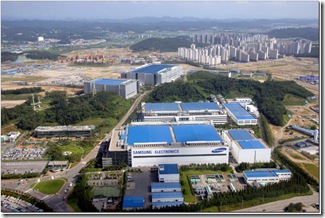
The consolidation plan signals that Samsung will focus more on AMOLED panel businesses than loss-making TFT-LCD production in the years to come, as TV makers are now looking to the self-luminescent AMOLED panel technology as a more profitable alternative TV technology to commodity and low-margin LCD TVs.
Once consolidated, the merged company will also be able to reuse its TFT, or thin film transistor-manufacturing facilities to produce AMOLED panels, as the TFT backplane can act as an actuator to switch on and off a grid of self-lighting organic materials to render moving images on the screen.
The possibility of easily converting already depreciated TFT facility into oxide-based silicon transistor backplane is another lure for a TFT-LCD panel maker like Samsung to jump on the AMOLED production, as they can forgo massive amounts of upfront capital investment to build the facilities.
AMOLED panels are a deposition and patterning of organic materials on TFT backplane to create a matrix of RGB, or white LEDs.
There are three backplane technology available today: a-Si(amorphous silicon), LTPS(low-temperature poly silicon), and a-Si-based oxide technology. The oxide backplane technology is known as the most cost-effective way to produce large size AMOLEDs.
Turn to lucrative AMOLED TVs
Samsung Electronics said in a regulatory filing on Feb 15 that the company is under consideration to spin off its LCD business and consolidate it with Samsung Mobile Display, the world’s largest AMOLED maker. The comments were a response to a flurry of questions being asked by the stock exchange about media reports about the plan.
Samsung Mobile Display is a joint-venture set up by Samsung Electronics and Samsung SDI Co. to make organic light-emitting diode, or OLED, panels.
Samsung’s LCD business racked up an operating loss of 750 billion in fiscal 2011, as an massive overhang of panel supply gluts and freefalls in the panel prices have combined to take a heavy toll on its profitability.
AMOLED panels are now being widely used with such mobile devices as smartphones and tablet PCs, but have many years to go before they become mainstay TV screen technology, because they are still far costlier than TFT-LCDs to produce.
For example, 55-inch AMOLED TVs are expected to sell for more than US$8,000, three times more expensive than TFT-LCD counterparts of the same screen size. Yet, AMOLEDs are the last resort that TFT-LCD and TV makers alike have to turn to as a next generation of growth engine for global TV markets.
To get a head-start in the just fledgling, potentially huge AMOLED TV markets, world No.1 and No. 2 TV makers- Samsung Electronics and LG Electronics- showcased 55-inch AMOLED TVs at CES 2012 trade show, and plan to sell them sometime in the second half of this year.
Taiwanese rivals stand chances
Market research company iSuppli forecasts that global shipments of AMOLED TVs would reach 34,100 units in 2012, but would skyrocket to 2.1 million units in 2015. Yet, that will still represent only 1 % of the global TV markets.
The consolidation also implies big shakeups in Samsung Electronics’ supply china networks. The LCD business unit has supplied over half of what Samsung needed to produce LCD TVs. For example, according to market research firm Display Search, 57% of Samsung TV production were built with its own—making LCD panels in 2011. The company also purchases millions of panels internally for production of notebook, monitors, and tablet PCs.
If the LCD business is spun off, Samsung is expected to look to panel makers in Taiwan to find third party low-cost panel suppliers, as even Samsung has been struggling to squeeze profits out of low-margin TV markets.
This shift in its supply chain system is also signaling big changes in Samsung’s vertical integration system that combine all of its business units vertically from TFT-LCDs, semiconductor chips , TVs, and mobile phones under one roof to get economies of scale.
The vertical integration system has played a big role in keeping Samsung less vulnerable than others to the global IT industry’s cyclical ups and downs, as sales setbacks in one area can be offset by booms in other areas. The system also has guaranteed on-time delivery and just-in-time production, greatly helping the company to cut back on overhead costs.

